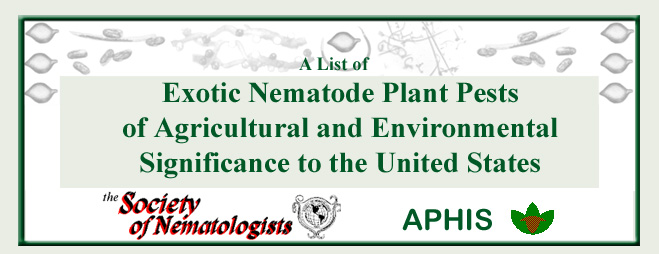| Primary Resources: Florida DPI Circulars (pest alerts), CIH
datasheets, CAB Crop Protection Compendium, CAB data base, EPPO Fact Sheets,
regulatory lists from other countries (Asian countries in particular),
an outdated APHIS list of nematodes of regulatory significance, a list
of foreign nematodes prepared by Zafar Handoo, and the expertise of nematologists
in the Working Group with representative experience from different regions
of the USA and also from South America, Europe, and Asia.
Key selection and ranking criteria: absence from or limited distribution
of the nematode in the US; known economic damage caused by the nematode;
host range; and the distribution and economic importance of the nematode’s
hosts in the US. Secondary factors considered are: introduction potential
and impact on exports. It was decided that introduction potential
should be of secondary importance because pathways can change over time.
Introduction and establishment potential would need to be investigated
further in a complete pest risk assessment (PRA) completed by APHIS. The
selections and rankings done by the group are based on the assumption that
present regulations stay in place (e.g., regulating the entry of soil).
Note: The rankings
for nematodes on the list (high, moderate, and low) are suggested
guidelines or priority ratings for APHIS to develop a timeframe for conducting
complete pest risk assessments (PRA). A low priority ranking should not
be interpreted as being equivalent to a low risk for US agriculture or
that minimal effort should be made to exclude these nematodes. Complete
pest risk assessments are needed for all of the nematodes on the list,
but this task requires resources and time beyond the scope of the current
project. About one fourth of the candidate nematodes suggested for the
list were given a very low priority ranking based on the Working Group
consensus that either there are few pathways for their introduction into
the US or because currently there is limited evidence that these nematodes
damage economically important crops. By group consensus these nematodes
(Table 3) were not included on the list. |








